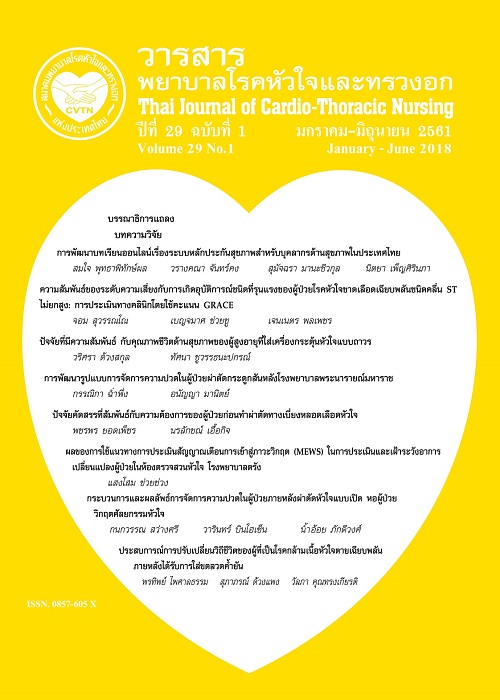Effects of using the assessment of the modified early warning signs (MEWS) in the assessment and monitoring change symptom of patients in cardiac catheterization lab, Trang hospital
Keywords:
Modified Early Warning (MEWS), Monitoring, cardiac catheterization labAbstract
The objective of this quasi experimental research was to study the effect of assessment guideline of The Modified Early Warning Signs (MEWS) in the cardiac catheterization lab, Trang Hospital. The subjects were divided in to two groups: 1) the experiment group using the guideline of MEWS was seven nurses operating in the cardiac catheterization lab, 224 patients who received cardiac catheterization in cardiac catheterization lab, 2) Subject of control group was 222 patients receiving routine nursing care during cardiac catheterization. The research tools consists of 1) Satisfaction questionnaire relating to the assessment and monitoring of change symptom of patients in the cardiac catheterization lab 2) Assessment guideline and monitoring of the change of patients in the cardiac catheterization lab. The data were analyzed using descriptive statistic, t-test and Chi Square.
The results found that the used of the assessment guideline of the Modified Early Warning Signs (MEWS) in experiment group increased in assessing patients and providing nursing in time and safety. The patients in the experimental group were safer than the controlled group significantly (p<.001). Nurses in the cardiac catheterization lab were satisfied in using the assessment form in agreement level at the most of 92%.
This study suggests that nurses in cardiac catheterization lab should use assessment guideline (MEWS) to prevent patients going into a critical condition and could help monitoring , report to physicians and provide treatment in time. This MEWS could effectively reduce complications and mortality rate.
References
2. The Heart Association of Thailand under the Royal Patronage of H.M. Condition of heart disease of pharmaceutical practice in treating patients of ischemic heart disease in the country or improved version on 2014. 2nd ed. Bangkok: Sri Muang Press Co.; 2014. (in Thai).
3. Haffner SM, Lehto S, Ronnema Y, Pyorala K, Lakaso M. Mortality from coronary heart disease in subject with type 2 diabetes and nondiabetic subjects with and without prior myocardial infarction. N Engl J Med. 1988; 339,229-34.
4. Killip T, Kimball JT. Treatment of myocardial infarction in coronary care unit: a two year experience with 250 patient. Amer. J. Cardiol. 1967 Oct; 20(4):457-64.
5. Heart center Trang Hospital. Heart disease statistics. Trang: Trang hospital; 2017. (in Thai).
6. Saenprasan P, Suparoj T, Jaemsomboon K, Prairun A, Suthipong N. Studying of symptom evaluation before critical condition in heart disease patients. Modified early warning sign in cardiac patient. [Internet]. 2016 [cited 2017 Jul 15]. Available from:http://www.thaicvt nurse.org/attachments/artucke/105/Room 1_2.pdf (in Thai).
7. Nakchuay P, Inprasong L, Tuntrakul W, Thongbai P, Chantanu P. MEWS : Adult Pre Arrest sign and nurse role. Sirirat Record Pharmaceutical Journal. 2560;10 (3) : 186-89. (in Thai).
8 Bulut M, Cebicci H, Sigirli D, Sak A, Durmus O, Top AA, et al. The comparison of modified early warning score with rapid emergency medicine score: a prospective multicentre observational cohort study on medical and surgical patients presenting to emergency department. Emerg Med J. 2014 Jun; 31(6):476–81 pmid:23562988
9. Nishijma l, Oyadomari S, Maeomari, S, Toma R, L gei C, Kobata S, et al. Use of a modified early warning score system to reduce the rate of in-hospital cardiac arrest. J Intensive care. 2016; 4:12. DOI 10.1186/s40560-016-0134-7
10. Bertalanffy LV. General system theory : foundations, development, applications. New York: George Braziller; 1968.
11. Fullerton JN, Price CL,, Silvey NE,, Brace SJ,, Perkins GD. Is the Modified Early Warning Score (MEWS) superior to clinician judgment in detecting critical illness in the pre-hospital environment. Resuscitation. 2012; 83 (5): 557-62.
12. Paterson R, MacLeod DC, Thetford D, Beattie A, Graham C, Lam S, Bell D. Prediction of in-hospital mortality and length of stay using an early warning scoring system : clinical audit. Clin Med (Lond). 2006; 6(3): 281-4.
13. Ritkla L. result of implementing patient assessment by using critical warning signal to moving into critical patient ward without planning and death rate in medical ward, Thammasart Chalermprakiat Hospital. Thammasart Chalerm Prakiat Hospital Journal. (TUH Journal online).2016;1: 5-12. (in Thai).
14. Peixoto RT, Peixoto EC, Sena MA, Tedeschi AL, Borges IP, Rachid MB.Gender influence on The immediate and medium term progression after primary percutaneous coronary intervention and analysis of independent risk factor for death or events. Arq Bras Cardiol. 2006;86(3):211-8
15. Mehta RH1, Starr AZ, Lopes RD, Hochman JS, Widimsky P, Pieper KS , et al. Incidence of And outcome associated with ventricular tachycardia or fibrillation in patients undergoing primary percutaneous coronary intervention. JAMA. 2009 May 6; 301(17):1779-89. doi: 10.1001/jama.2009.600.
16. Stafseth SK, Gronbecks, Lien T, Ronden L, Lerdal A. The experiences of nurse implementing the modified Early Warning score and a 24 hour on call mobile Intensive Care Nurse: An exploratory study. Intensive Crit Care Nurs. 2016; 34; 25-33.
17. Shaddel F, Khosla V,Banerjee S. Effects of introducing MEWS on nursing staff in mental health inpatient settings. Prog Neurol Psychiatry. 2106; 2(18): 24-27.
Downloads
Published
How to Cite
Issue
Section
License
บทความนี้ยังไม่เคยตีพิมพ์หรืออยู่ในระหว่างส่งไปตีพิมพ์ในวารสารอื่น ๆ มาก่อน และกองบรรณาธิการขอสงวนสิทธิ์ในการตรวจทาน และแก้ไขต้นฉบับตามเกณฑ์ของวารสาร ในกรณีที่เรื่องของท่านได้ได้รับการตีพิมพ์ในวารสารฉบับนี้ถือว่าเป็น ลิขสิทธิ์ของวารสารพยาบาลโรคหัวใจและทรวงอก






